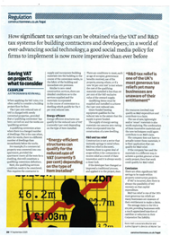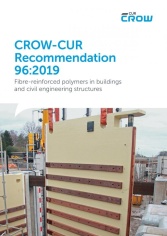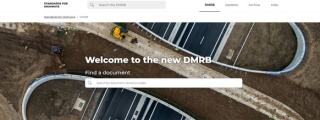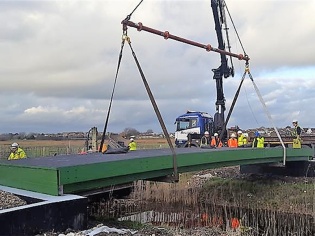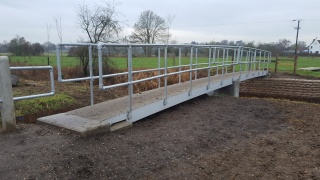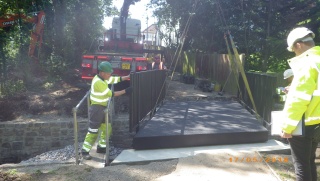The use of an FRP Bridge could qualify for an R&D Tax Relief.
/ Martin Richardson / CD368, CD368, CUR96, CUR96, Cycleway, Footbridge, Footbridge, FRP Composites, Pedestrian
Very few people in the construction industry are aware of the significant commercial opportunity from identifying R&D processes and expenditure within the business. If a contractor has changed or improved a traditional process, and applied it to the project, then the resources involved may qualify as R&D expenditure and contribute to a claim. By offering an alternative construction technique using a Lifespan Structures composite deck, clients can often qualify for an R&D claim which will reduce the tendered costly of the scheme or enhance the profit margin.
CROW-CUR Recommendation 96:2019 - Now Available in English
/ Martin Richardson / BD90/05, CD368, CD368, CUR96, CUR96, Footbridge, Footbridge, FRP Composites, Pedestrian
The English Version of CUR96 is now available! CUR96 Recommendation describes the principles for the design of fibre-reinforced polymers (FRP)
It is available for download at https://crowplatform.com/product/crow-cur-recommendation-962019/
Please do contact us directly if you would like a to understand more about the content of this document.
The revised DMRB replaces BD90/05 with CD368
/ Martin Richardson / BD90/05, BD90/05, CD368, CD368, CUR96, CUR96, Cycleway, Footbridge, FRP Composites, Pedestrian
The DMRB was updated by Highways England just before the lockdown started. We were probably all distracted from noticing this at the time. The technical changes were substantial, especially regarding FRP bridges but the structure of the suite of documents changed. A summary of these changes can be seen at (https://standardsforhighways.co.uk/dmrb/help#new-structure)
One key change for us is the replacement of BD90/05 with CD368. CD368 updates the approach to FRP bridges. The new approach is now quite closely aligned with current European guidance documents.
FRP Composites provide a sustainable solution
/ Martin Richardson / BD90/05, BD90/05, Composite, Composite, CUR96, Footbridge, Footbridge, FRP Composites, FRP Composites, Pedestrian, Pedestrian
The construction industry is committed to reducing the environmental impact of its activities. The Construction 2025 joint strategy from the UK Government and industry, working in partnership, sets a vision, which includes 50% lower emissions, 33% lower costs and 50% faster delivery. Using FRP composites in place of steel and concrete for bridge construction will deliver this vision now. The carbon and energy embodiment is significantly reduced at the construction stage and still further during the 100-year minimum service life.
PROW Benefits from new 2 span FRP Footbridge
/ Martin Richardson / Bridleway, CUR96, Footbridge, Footpath, FRP Composites, FRP Composites, Lightweight, Pedestrian, Pedestrian, PROW, PROW, Timber Footbridge
This Public Rights of Way (PROW), 2 span bridge was installed in December 2018. The lightweight nature allowed easy installation in this remote location during the winter months and moulded deck technology means long term maintenance will be reduced to a minimum. The total length of the bridge was 14m and 0.905m wide between the handrails. The handrails were attached to the outside edge of the bridge to minimise the overall width of the structure to suit site constraints. The project demonstrates that FRP bridges can be a cost effective, durable alternative to traditional construction methods for small remote structures.
Hounsden Gutter Project Completed
/ Martin Richardson / BD90/05, BD90/05, Carbon Fibre, Composite, Composite, CUR96, CUR96, Cycleway, Footbridge, Footbridge, FRP Composites, FRP Composites, Pedestrian, Timber Footbridge, Uncategorized
The existing skewed reinforced concrete footbridge had come to the end of it life, so an FRP Replacement was selected to provide reduced maintenance in the tree enclosed environment over the Gutter. Following completion of new abutments and associated retaining walls, the lightweight, preformed, replacement allowed fast and simple installation on site using a lorry mounted crane, to both transport and lift the bridge into place. The colour scheme was selected to match the clients requirements.
FRP Bridges on Horsey Cycleway Highly Commended by ICE
/ Martin Richardson / Awards, BD90/05, BD90/05, Composite, CUR96, CUR96, Cycleway, FRP Composites, FRP Composites, Lightweight, Pedestrian
Lifespan Structures FRP cycleway Bridges on Horsey Way, Eastbourne, were highly commended at the 2018 ICE South East England Engineering Excellence awards in the best infrastructure category..no mean feat when going up against much larger schemes, congratulations to all involved in the project! The new Horsey Cycleway crosses a wetlands area where two footbridges with service vehicle access were required to cross waterways on the route. Due to the poor ground conditions the bridges needed to be lightweight to aid installation and reduce the abutment loadings. The client, had already used an FRP composite footbridge on a previous scheme and commissioned Lifespan Structures to design and manufacture the two FRP composite Footbridges. The bridges were both 3.0m wide and had clear spans of 14.8m and 10.6m with respective deck weights of 5600kg and 3350kg.
FRP Bridge at Sedlescombe - Over 3 years old.
/ Martin Richardson / BD90/05, BD90/05, Carbon Fibre, Composites UK, CUR96, Footbridge, Footbridge, Footpath, FRP Composites, FRP Composites, Lightweight, Pedestrian, Pedestrian, Timber Footbridge, Timber Footbridge, Wooden Footbridge
600kg FRP bridge deck replaces a 2-3000kg timber bridge, delivered and put in place in just a few hours. The installation of our first generation of lightweight footbridge structures is over 3 years ago now.
Off Site Construction of FRP Footbridge Reduces Construction Times
/ Martin Richardson / BD90/05, BD90/05, Composite, Composites UK, Fibercore, Footbridge, Footbridge, FRP Composites, FRP Composites, Lightweight, Off Site, Pedestrian, Steel Footbridge
Off site construction, means bridge production can continue all year round, and minimises installation times. This bridge replaces a corroded steel structure which had reached the end of its service life.
Lightweight Cycleway Bridge Delivered
/ Martin Richardson / BD90/05, BD90/05, Composite, Composites UK, Cycleway, Fibercore, Footbridge, Footbridge, FRP Composites, FRP Composites, Lightweight, Pedestrian
Lightweight FRP bridge deck for cycleway delivered. The 15m by 3m structure has been constructed off site and is being unloaded using a lorry mounted crane. Low dead weights allow simplified foundations especially where poor ground conditions exist.

